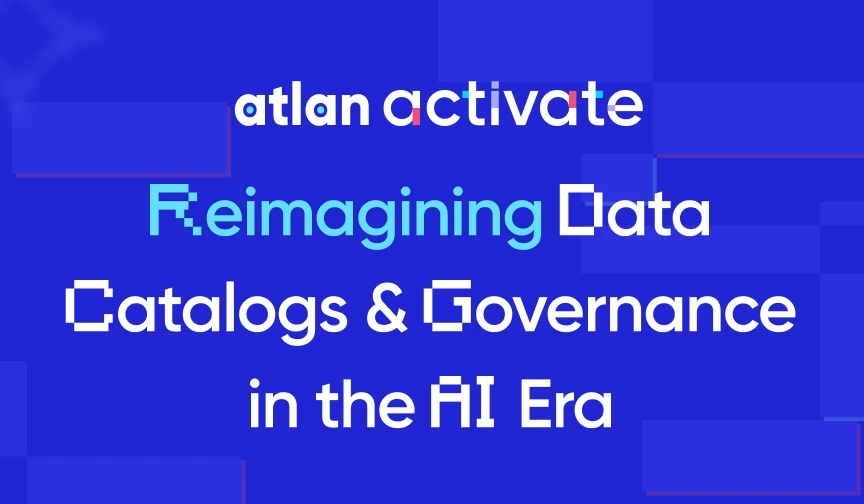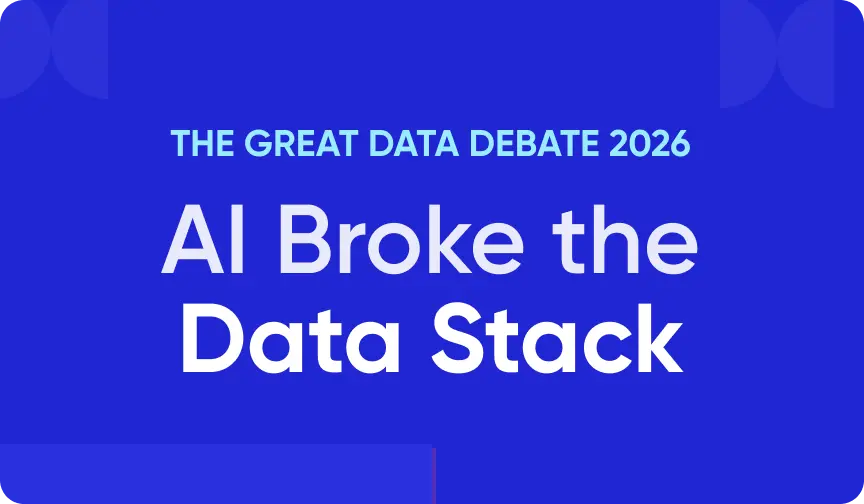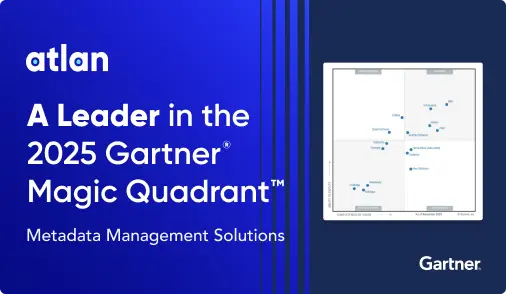Automated Data Stewardship: Why You Can’t Do Without It
Share this article
Data stewards are the keepers of data quality and accuracy within a company, and their jobs are becoming progressively more complex. Data volumes grow exponentially as businesses increasingly depend on data to drive decisions and strategy. At the same time, Gen AI use cases are demanding ever more high-volume, high-quality data.
See How Atlan Simplifies Data Governance – Start Product Tour
What data stewards need is automation. Existing data governance tools are already quite powerful for applying automation across your entire data estate, and AI is rapidly expanding its automation capabilities.
In the same way that GitHub’s Copilot AI code assistance tool makes developers 55% faster and 75% more fulfilled in their work, a data stewardship copilot can make data stewards more effective and more efficient in their jobs.
In this article, we’ll show how automated data stewardship can complement the work of data stewards, as well as some best practices for augmenting stewardship with AI co-pilots.
Table of Contents
Permalink to “Table of Contents”- What is automated data stewardship?
- The benefits of automated data stewardship
- How to implement automated data stewardship
- Guidelines for effective automated data stewardship
- Conclusion
- Related reads
What is automated data stewardship?
Permalink to “What is automated data stewardship?”Data stewardship is a collection of data management responsibilities that ensure business users have access to trustworthy, high-quality data. As the implementers and guardians of a company’s data governance policies, data stewards touch every phase of the data life cycle, from data creation to destruction.
Automated data stewardship is when data stewards work with a data management system that frees them from manual data management and the data siloes this commonly creates within an organization.
- Automated data stewardship encapsulates the knowledge of data stewards throughout the company, standardizing it and capturing it in a set of repeatable rules.
- An automated data management tool can also suggest new rules, such as data classifications, that it detects based on analyzing your organization’s data.
The benefits of automated data stewardship
Permalink to “The benefits of automated data stewardship”Automated data stewardship has several key benefits:
- More scalable and distributed than manual stewardship
- Frees up data stewards’ time
- Reduces human error
- Standardizes key data governance functions
- Improves data quality and governance compliance
Let’s look at each one in detail.
More scalable and distributed than manual stewardship
Permalink to “More scalable and distributed than manual stewardship”IDC estimates that the world will host 181 zettabytes of data by 2025. Most large companies are managing 400 or more data sources. The only way to ensure this data is governed is to distribute the workload while giving teams new tools to inspect, analyze, clean, and categorize data at scale.
In the past, data governance was a purely top-down and mostly manual effort. Now, though, new approaches like data mesh architecture have emerged to serve the steady growth of data in companies.
- In a data mesh architecture, data domain owners maintain their own data, data pipelines, and domain-specific data quality rules.
- Automated data stewardship, meanwhile, works in the background to perform checks, monitoring, and alerting to enforce organizational-wide policies on the data (e.g., ensuring sensitive information is tagged).
- Implementing automated data stewardship within a data mesh architecture is an inherently scalable data governance approach because it allows for a new distribution of data-related roles and responsibilities. Some data stewards can curate trustworthy data at the domain level, while others monitor and maintain overall governance and compliance.
Saves time
Permalink to “Saves time”Let’s be honest — devising new standards and policies is the fun part of a data steward’s job. Applying these to millions, even billions, of records? Not so much.
Fortunately, properly implemented and quality-tested automation can reduce the time required to apply data governance policies to data by a factor of ten or more.
- Companies are using automated data stewardship to deliver high-quality data solutions into production faster than ever before.
- UK-based digital bank Tide, for example, originally estimated that identifying, tagging, and securing personal data across the org’s entire data estate would take about three months to achieve.
- By using Atlan Playbooks for bulk automation, though, they dropped three months down to five hours.
Reduces human error
Permalink to “Reduces human error”In 2017, Amazon Web Services’ massive and ubiquitous object storage system, Amazon S3, went offline for several hours.
The culprit? An incorrect input entered by a technician debugging the S3 billing system. Unfortunately, errors are a fact of life, even among highly-trained professionals.
- Using automation to incorporate checks against previous (and possible future) errors reduces the odds that a bad command-line switch will become a million-dollar problem.
Standardizes key data governance functions
Permalink to “Standardizes key data governance functions”Automated data governance checks can ensure that some standards (for example, format of customer IDs or definition of critical sales figures) are globally and consistently enforced within an organization.
- This reduces onboarding and training time when new personnel can learn key rules as their automated stewardship copilot flags — and then helps them correct — their mistakes.
Improves data quality and compliance
Permalink to “Improves data quality and compliance”In data governance programs, AI copilot functions can help improve data quality and overall compliance by detecting patterns that humans can’t, particularly across massive and complex datasets.
- AI can detect subtle anomalies that indicate possible data quality issues, such as sudden changes in data distributions, missing values, or unusual patterns.
- For example, if a subset of customer addresses diverges from historical norms, AI might catch this change as a potential quality issue faster than a human could — especially when patterns are subtle and scattered across many records.
- AI can also identify potential privacy compliance risks in unstructured data. It can scan unstructured text fields or document repositories for patterns or keywords that indicate the presence of sensitive data (like personal identifiers or health information).
- For example, AI can reduce compliance risks for regulatory standards like GDPR or HIPAA by identifying sensitive content that was not properly flagged.
How to implement automated data stewardship
Permalink to “How to implement automated data stewardship”Existing data governance automation tools already go a long way in applying automated governance across your data estate; now, advances in Gen AI are rapidly expanding automation capabilities.
Here are the current automated data stewardship features you should consider adopting:
- Auto-constructed data lineage
- Data quality automation
- Policy creation and enforcement
- AI data steward
Auto-constructed data lineage
Permalink to “Auto-constructed data lineage”Data lineage shows the flow of data as it travels across your data estate.
- For example, it can show the multiple source tables from which an authoritative dataset of customers or monthly sales figures is drawn.
Automated data lineage automatically ingests data and metadata updates, giving you a full and accurate map of where data came from, who last touched it, how it’s changed over time, etc.
- This information is crucial to help data stewards assess data trustworthiness and rapidly catch data quality issues to correct them at their source.
Data quality automation
Permalink to “Data quality automation”Data quality automation performs data quality checks and corrections as new data passes through a data ingestion pipeline:
- Data pipeline owners can create data quality tests to verify correctness before making changes available to downstream consumers.
- A data pipeline can issue alerts and notifications if it detects issues or anomalies that can’t be resolved automatically.
- Data stewards can then use tools like data lineage to find and fix these errors before they cause havoc in downstream data products like reports.
Data stewards can also monitor data quality metrics dashboards that provide key information on the overall condition of their datasets.
- A steward can judge in a single glance that a dataset meets Key Performance Indicators (KPIs) for accuracy, timeliness, completeness, and other metrics.
- Using data usage metrics dashboards, data stewards can identify the datasets most valuable to the business.
- They can also uncover datasets that can be consolidated or archived to save money on data processing costs.
Policy creation and enforcement
Permalink to “Policy creation and enforcement”Automation is indispensable for using data lineage to automatically propagate data standards and policies.
- For example, an automated process can use data policies to enforce access permission automatically using role-based access control (RBAC), or propagate data classification sensitivity tags using lineage.
AI data steward
Permalink to “AI data steward”An “AI data steward” doesn’t replace human data stewards. It acts as an automated copilot, assisting in automated metadata extraction and analyzing large volumes of real-time data to detect patterns.
- For example, Atlan’s AI data steward can assist in diverse tasks, including policy creation and suggesting data classifications for compliance and access control. Atlan AI can also make documentation suggestions so you can document 55% or more of your data estate automatically.
Guidelines for effective automated data stewardship
Permalink to “Guidelines for effective automated data stewardship”Automation is only as good as the people who create and manage it. You can get the most out of automated data stewardship by:
- Keeping humans in the loop
- Supporting low-code or no-code solutions
Keep humans in the loop
Permalink to “Keep humans in the loop”Automation, and AI in particular, works best when used to enhance — not replace — human intelligence.
- Human in the Loop (HITL) workflows give data stewards the final say in whether an automated or AI-generated result passes the sniff test.
- Pairing automation with human acumen results in greater accuracy and better results for customers by creating better-trained models and broadening the range of tasks that automated processes can handle autonomously.
- HITL is a necessity for many Gen AI workflows, where hallucinations or data bias can result in harmful outcomes.
- Emerging legislation like the EU AI Act requires HITL for high-risk scenarios, such as aviation vehicles, infrastructure management, and law enforcement, among other use cases.
Support no-code or low-code solutions
Permalink to “Support no-code or low-code solutions”As data-driven use cases proliferate in business, it’s important to make the data stewardship role accessible to as many people as possible in your organization.
- No-code and low-code editors enable people to develop playbooks and enforce data governance policies even if they aren’t expert programmers.
- They also reduce unnecessary burdens on IT and shorten the time required to implement time-saving automated data quality and governance workflows.
- For example, Atlan’s Policy Editor is a no-code editor that data stewards can use to create, document, and submit policies for approval — and also manage exceptions — all via an easy-to-use SaaS UI.
Conclusion
Permalink to “Conclusion”Data stewards are working in an increasingly fast-paced, hectic, and complicated data climate. Automated data stewardship tools such as playbooks, policies, and AI copilots can help by enabling stewards to standardize their knowledge and offload repetitive, mechanical tasks. The result is better data quality at modern scale.
Learn more about how Atlan makes automated data stewardship a reality: contact us for a demo today.
Automated Data Stewardship: Related reads
Permalink to “Automated Data Stewardship: Related reads”- What is Data Governance? Its Importance & Principles
- Data Governance and Compliance: Act of Checks & Balances
- Data Governance Framework — Guide, Examples, Template
- Data Compliance Management in 2025
- BCBS 239 Compliance: What Banks Need to Know in 2025
- BCBS 239 Data Governance: What Banks Need to Know in 2025
- BCBS 239 Data Lineage: What Banks Need to Know in 2025
- HIPAA Compliance: Key Components, Rules & Standards
- CCPA Compliance: 7 Requirements to Become CCPA Compliant
- CCPA Compliance Checklist: 9 Points to Be Considered
- How to Comply With GDPR? 7 Requirements to Know!
- Benefits of GDPR Compliance: Protect Your Data and Business in 2025
- IDMP Compliance: It’s Key Elements, Requirements & Benefits
- Data Governance for Banking: Core Challenges, Business Benefits, and Essential Capabilities in 2025
- Data Governance Maturity Model: A Roadmap to Optimizing Your Data Initiatives and Driving Business Value
Share this article





















